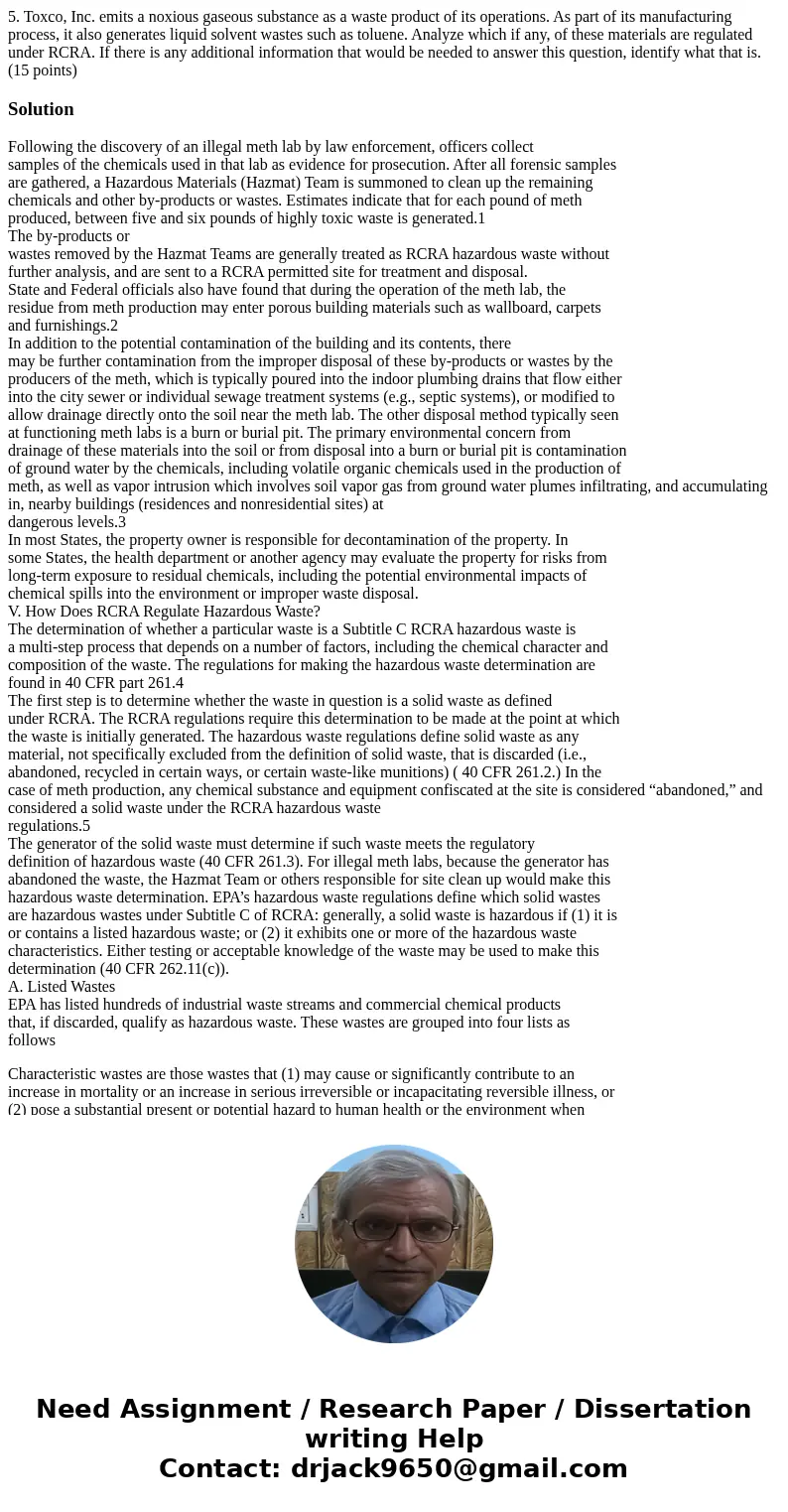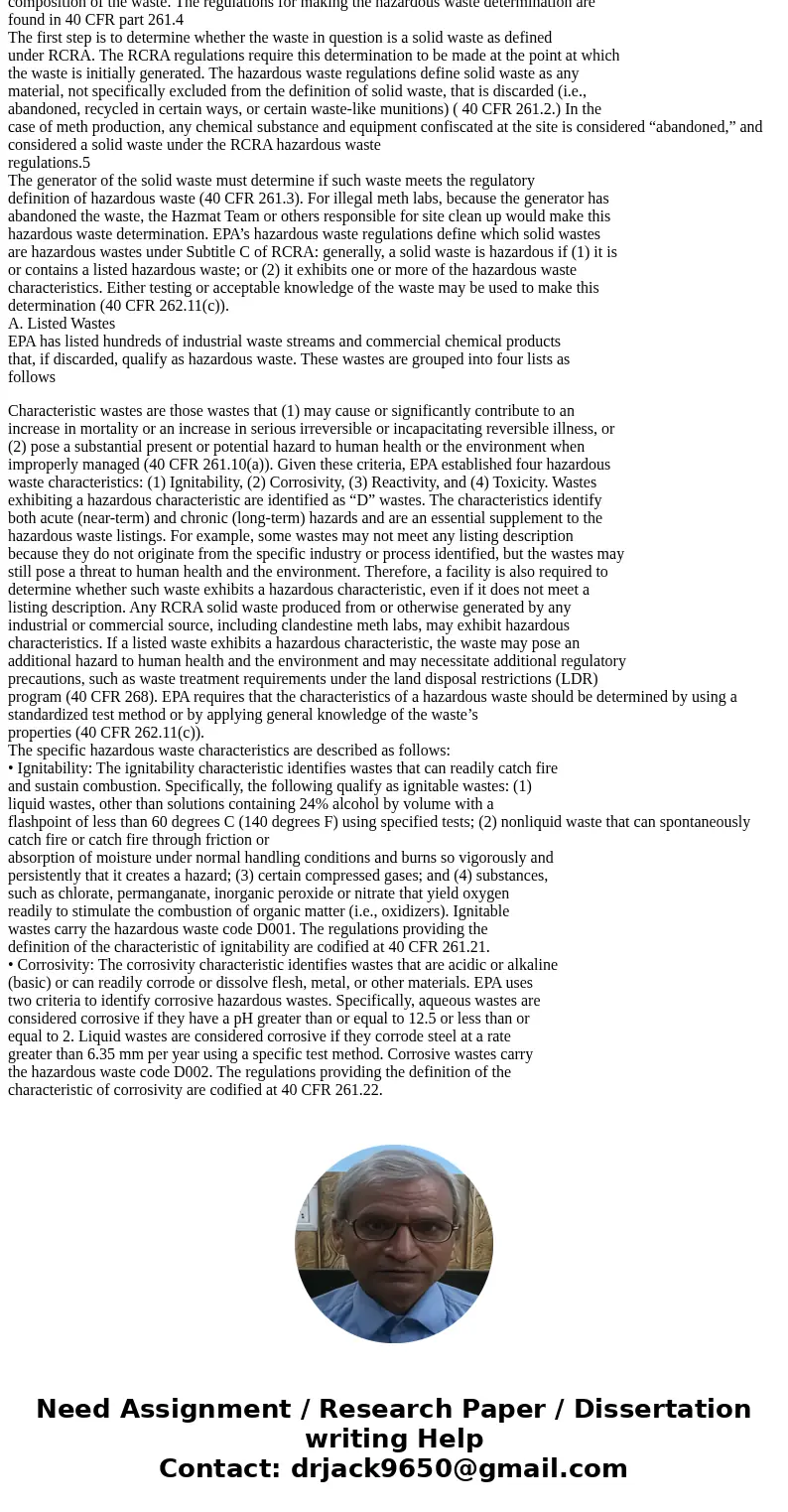5 Toxco Inc emits a noxious gaseous substance as a waste pro
Solution
Following the discovery of an illegal meth lab by law enforcement, officers collect
samples of the chemicals used in that lab as evidence for prosecution. After all forensic samples
are gathered, a Hazardous Materials (Hazmat) Team is summoned to clean up the remaining
chemicals and other by-products or wastes. Estimates indicate that for each pound of meth
produced, between five and six pounds of highly toxic waste is generated.1
The by-products or
wastes removed by the Hazmat Teams are generally treated as RCRA hazardous waste without
further analysis, and are sent to a RCRA permitted site for treatment and disposal.
State and Federal officials also have found that during the operation of the meth lab, the
residue from meth production may enter porous building materials such as wallboard, carpets
and furnishings.2
In addition to the potential contamination of the building and its contents, there
may be further contamination from the improper disposal of these by-products or wastes by the
producers of the meth, which is typically poured into the indoor plumbing drains that flow either
into the city sewer or individual sewage treatment systems (e.g., septic systems), or modified to
allow drainage directly onto the soil near the meth lab. The other disposal method typically seen
at functioning meth labs is a burn or burial pit. The primary environmental concern from
drainage of these materials into the soil or from disposal into a burn or burial pit is contamination
of ground water by the chemicals, including volatile organic chemicals used in the production of
meth, as well as vapor intrusion which involves soil vapor gas from ground water plumes infiltrating, and accumulating in, nearby buildings (residences and nonresidential sites) at
dangerous levels.3
In most States, the property owner is responsible for decontamination of the property. In
some States, the health department or another agency may evaluate the property for risks from
long-term exposure to residual chemicals, including the potential environmental impacts of
chemical spills into the environment or improper waste disposal.
V. How Does RCRA Regulate Hazardous Waste?
The determination of whether a particular waste is a Subtitle C RCRA hazardous waste is
a multi-step process that depends on a number of factors, including the chemical character and
composition of the waste. The regulations for making the hazardous waste determination are
found in 40 CFR part 261.4
The first step is to determine whether the waste in question is a solid waste as defined
under RCRA. The RCRA regulations require this determination to be made at the point at which
the waste is initially generated. The hazardous waste regulations define solid waste as any
material, not specifically excluded from the definition of solid waste, that is discarded (i.e.,
abandoned, recycled in certain ways, or certain waste-like munitions) ( 40 CFR 261.2.) In the
case of meth production, any chemical substance and equipment confiscated at the site is considered “abandoned,” and considered a solid waste under the RCRA hazardous waste
regulations.5
The generator of the solid waste must determine if such waste meets the regulatory
definition of hazardous waste (40 CFR 261.3). For illegal meth labs, because the generator has
abandoned the waste, the Hazmat Team or others responsible for site clean up would make this
hazardous waste determination. EPA’s hazardous waste regulations define which solid wastes
are hazardous wastes under Subtitle C of RCRA: generally, a solid waste is hazardous if (1) it is
or contains a listed hazardous waste; or (2) it exhibits one or more of the hazardous waste
characteristics. Either testing or acceptable knowledge of the waste may be used to make this
determination (40 CFR 262.11(c)).
A. Listed Wastes
EPA has listed hundreds of industrial waste streams and commercial chemical products
that, if discarded, qualify as hazardous waste. These wastes are grouped into four lists as
follows
Characteristic wastes are those wastes that (1) may cause or significantly contribute to an
increase in mortality or an increase in serious irreversible or incapacitating reversible illness, or
(2) pose a substantial present or potential hazard to human health or the environment when
improperly managed (40 CFR 261.10(a)). Given these criteria, EPA established four hazardous
waste characteristics: (1) Ignitability, (2) Corrosivity, (3) Reactivity, and (4) Toxicity. Wastes
exhibiting a hazardous characteristic are identified as “D” wastes. The characteristics identify
both acute (near-term) and chronic (long-term) hazards and are an essential supplement to the
hazardous waste listings. For example, some wastes may not meet any listing description
because they do not originate from the specific industry or process identified, but the wastes may
still pose a threat to human health and the environment. Therefore, a facility is also required to
determine whether such waste exhibits a hazardous characteristic, even if it does not meet a
listing description. Any RCRA solid waste produced from or otherwise generated by any
industrial or commercial source, including clandestine meth labs, may exhibit hazardous
characteristics. If a listed waste exhibits a hazardous characteristic, the waste may pose an
additional hazard to human health and the environment and may necessitate additional regulatory
precautions, such as waste treatment requirements under the land disposal restrictions (LDR)
program (40 CFR 268). EPA requires that the characteristics of a hazardous waste should be determined by using a standardized test method or by applying general knowledge of the waste’s
properties (40 CFR 262.11(c)).
The specific hazardous waste characteristics are described as follows:
• Ignitability: The ignitability characteristic identifies wastes that can readily catch fire
and sustain combustion. Specifically, the following qualify as ignitable wastes: (1)
liquid wastes, other than solutions containing 24% alcohol by volume with a
flashpoint of less than 60 degrees C (140 degrees F) using specified tests; (2) nonliquid waste that can spontaneously catch fire or catch fire through friction or
absorption of moisture under normal handling conditions and burns so vigorously and
persistently that it creates a hazard; (3) certain compressed gases; and (4) substances,
such as chlorate, permanganate, inorganic peroxide or nitrate that yield oxygen
readily to stimulate the combustion of organic matter (i.e., oxidizers). Ignitable
wastes carry the hazardous waste code D001. The regulations providing the
definition of the characteristic of ignitability are codified at 40 CFR 261.21.
• Corrosivity: The corrosivity characteristic identifies wastes that are acidic or alkaline
(basic) or can readily corrode or dissolve flesh, metal, or other materials. EPA uses
two criteria to identify corrosive hazardous wastes. Specifically, aqueous wastes are
considered corrosive if they have a pH greater than or equal to 12.5 or less than or
equal to 2. Liquid wastes are considered corrosive if they corrode steel at a rate
greater than 6.35 mm per year using a specific test method. Corrosive wastes carry
the hazardous waste code D002. The regulations providing the definition of the
characteristic of corrosivity are codified at 40 CFR 261.22.


 Homework Sourse
Homework Sourse